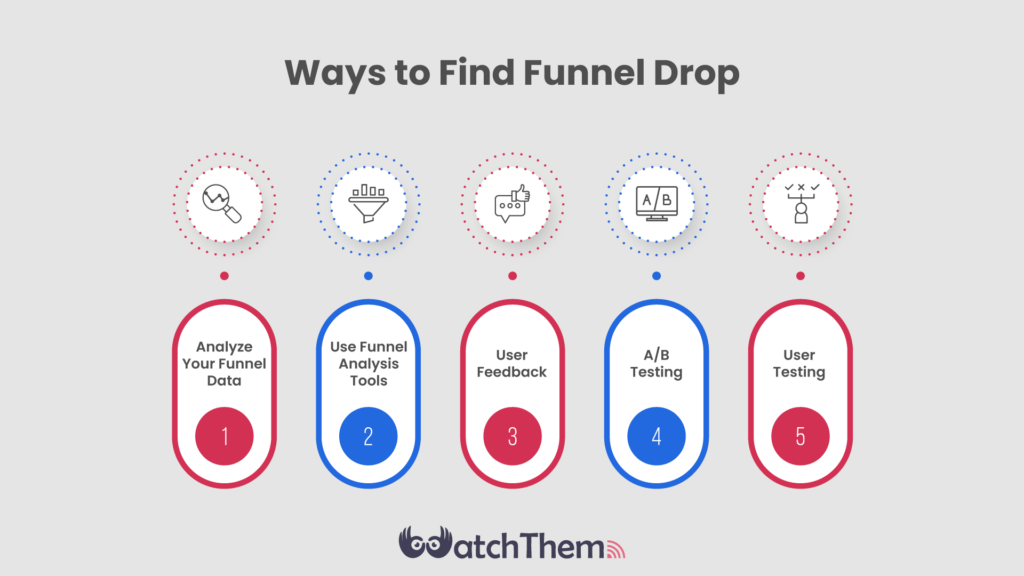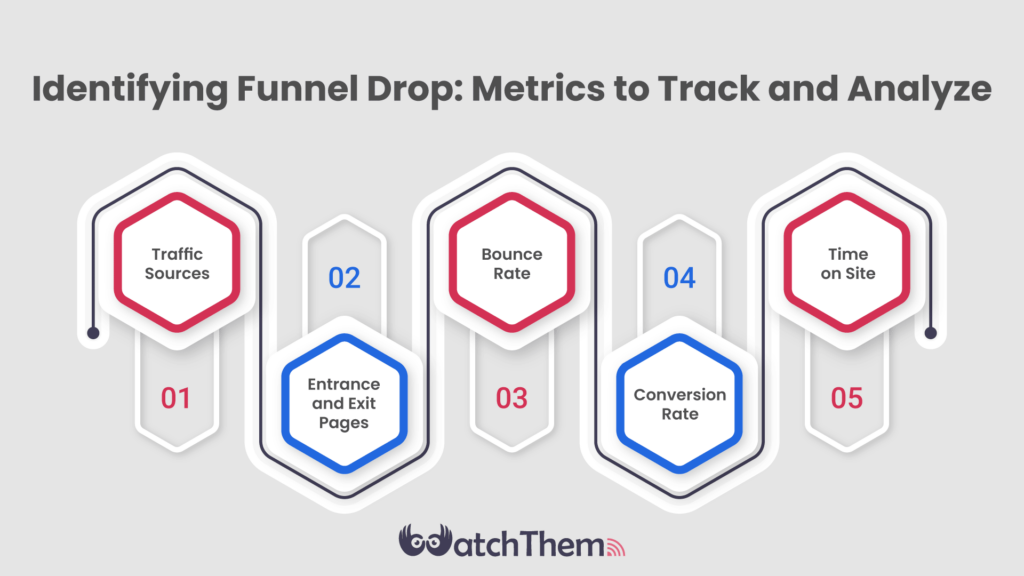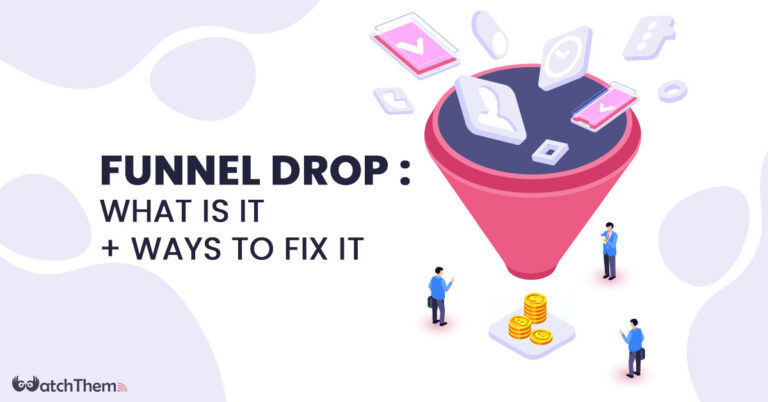Page Contents
Funnel drop is a common problem that many businesses face when it comes to converting website visitors into paying customers. It refers to the point in the customer journey where visitors abandon the buying process.
There are many platforms that can help business owners to keep track of their funnels and monitor their progress and growth such as CRO tools.
At WatchThemLive, we understand the importance of reducing funnel drop to increase conversion rates. Our all-in-one CRO tool allows you to watch recordings of user sessions on your website, giving you valuable insights into user behavior and how to improve your website’s conversion rate.
So make sure to sign up now and seize your free plan!
What Is Funnel Drop
Funnel drop is the term used to describe the point in the customer journey where visitors abandon the buying process. This can happen at any stage of the funnel, whether it’s the landing page, product page, shopping cart, or checkout.
When visitors drop off at any stage, it negatively impacts your conversion rate and your bottom line.
5 Ways to Find Funnel Drop
To identify and fix funnel drops, you need to analyze your funnel data and pinpoint the specific points where users are dropping off.
There are several ways to find funnel drop. Here’s a list to help you better understand!


#1 Analyze Your Funnel Data
One of the best ways to find funnel drop is by analyzing your funnel data using website analytic tools. By looking at metrics such as bounce rate, time on site, and conversion rate, you can identify where visitors are dropping off in the funnel.
For example, if you notice that the majority of visitors are dropping off on the product page, you may need to make adjustments to that page to increase conversions.
#2 Use Funnel Analysis Tools
Another way to find funnel drop is by using funnel analysis tools. These tools allow you to visualize the customer journey and identify where visitors are dropping off. By using funnel analysis tools, you can quickly pinpoint problem areas and make data-driven decisions to improve your conversion rate.
WatchThemLive is an innovative funnel analysis tool that helps businesses optimize their conversion funnel and increase their revenue. With its powerful features and real-time insights, WatchThemLive provides you with the tools you need to analyze your funnel data, identify areas of drop-off, and make data-driven decisions to optimize your funnels.
How WatchThemLive Can Help
At WatchThemLive, we offer a powerful behavioral analytic tool that allows you to watch recordings of user sessions on your website. By using WatchThemLive, you can identify funnel drop, optimize your website, and increase your conversion rate. Some of the ways that WatchThemLive can help you include:
- Heat Maps and Session Replays
Heat maps and session replays allow you to observe how users interact with your website or app, identify areas where they might be getting stuck or losing interest, and make data-driven decisions to improve your funnel’s conversion rate.
- Visual Live Chat
WatchThemLive’s visual live chat feature allows you to engage with users in real-time and get immediate feedback on their experience. This can help you identify issues and pain points quickly, and make targeted changes to improve the user experience and increase your conversion rate.
- Video Testimonials
Using the video testimonials feature provides you with real-time feedback from actual users. With this feature, you can see and hear first-hand how users are interacting with your website or app, and use that information to make informed decisions about how to optimize your conversion funnel.
- Advanced Analytics
WatchThemLive provides you with advanced analytics, including funnel tracking, exit page analysis, and traffic source analysis. You can use these insights to identify areas of your funnel that are causing users to drop off and make targeted changes to improve your overall conversion rate.
#3 User Feedback
Collect user feedback using surveys, polls, or customer support interactions to better understand the reasons why users are leaving your digital marketing funnel. Use this feedback to identify pain points and areas of improvement.
#4 A/B Testing
Business owners can use A/B testing to test different versions of their funnel and identify which one performs best. By testing different elements of the funnel, such as the layout, copy, or calls to action, you can identify the changes that have the biggest impact on your conversion rate.
#5 User Testing
Conduct user testing to observe how users interact with your website or app, and identify where they might be getting stuck or losing interest. By watching users navigate your funnel, you can identify areas for improvement and optimize the user experience.
Understanding Funnel Drop: Causes and Consequences
There are many potential causes of funnel drop, and understanding these causes is critical to reducing drop-off and increasing conversions. Some common causes of funnel drop include:
#1 Poor User Experience
If your website is difficult to navigate or has confusing or unclear messaging, visitors may become frustrated and leave before completing the desired action.
#2 Slow Loading Times
If your website takes too long to load, visitors may become impatient and leave before completing the desired action.
#3 Lack of Trust
If your website doesn’t inspire trust or credibility, visitors may be hesitant to provide sensitive information or make a purchase.
#4 Technical Issues
If your website experiences technical issues or errors, visitors may be unable to complete the desired action, leading to a funnel drop.
#5 Lack of Clarity
If your website’s messaging is unclear or confusing, visitors may not understand the value proposition or the intended action, leading to drop-off.
The consequences of funnel drop can be significant, both in terms of lost revenue and lost opportunities. Each drop-off represents a missed opportunity to convert a visitor into a customer, and over time, these missed opportunities can add up to a significant loss in potential revenue.
However, by understanding the causes of funnel drop and using tools like WatchThemLive to analyze user behavior and improve the customer experience, you can reduce drop-off and increase conversions, leading to improved revenue and a stronger bottom line.
Identifying Funnel Drop: Metrics to Track and Analyze
Tracking and analyzing metrics related to your conversion funnel is critical to identifying areas of drop-off and taking targeted action to address them. Here are some key metrics to consider when analyzing your conversion funnel:


#1 Traffic Sources
It’s important to track where your website traffic is coming from, as this can give you insights into which channels are driving the most engaged visitors. By identifying which channels are driving the most visitors that convert, you can focus your marketing efforts on those channels and potentially reduce drop-off.
#2 Entrance and Exit Pages
Tracking the pages where visitors enter and exit your website can help you identify where drop-off is occurring in your conversion funnel. By analyzing these pages and making targeted improvements, you can potentially reduce drop-off and improve conversions.
#3 Bounce Rate
it’s the percentage of visitors who leave your website after only viewing one page. A high bounce rate can be an indication that your website is not engaging visitors effectively, potentially leading to drop-off and lost conversions.
Pro Tip: you can learn more about what is considered a good bounce rate here.
#4 Conversion Rate
This metric is the percentage of visitors who complete the desired action, such as making a purchase or filling out a form. By tracking your conversion rate and making targeted improvements to your website, you can potentially increase conversions and reduce drop-off.
#5 Time on Site
Tracking how long visitors spend on your website can give you insights into engagement levels and potential drop-off points. By analyzing user behavior data and making targeted improvements to your website, you can potentially reduce drop-off and improve engagement.
By tracking and analyzing these metrics, you can identify areas of drop-off and take targeted action to reduce drop-off.
Reducing Funnel Drop: Strategies and Tactics
Reducing funnel drop requires a multifaceted approach that involves analyzing user behavior data, making targeted improvements to your website, and optimizing your conversion funnel at every stage.
Here are some key strategies and tactics to consider when addressing funnel drop:
#1 Improve User Experience
By enhancing the UX of your website, you can reduce drop-off and increase conversions. This can involve following website design best practices, navigation, messaging, and content to ensure that visitors can easily find what they’re looking for and understand the value proposition of your product or service.
#2 Optimize Landing Pages
The first point of contact for visitors to your website is landing pages, and optimizing these pages for conversion is critical to reducing drop-off. This can involve making targeted improvements to page design, messaging, and calls-to-action to ensure that visitors are motivated to take the desired action.
#3 Streamline Checkout Process
For e-commerce websites, the checkout process is a critical stage in the conversion funnel, and optimizing this process can help reduce drop-off and increase conversions.
This can involve simplifying the checkout process, minimizing form fields, and providing clear messaging and instructions to help visitors complete the checkout process with ease.
#4 Implement Retargeting Campaigns
An effective way to re-engage visitors who have dropped off at various stages of the conversion funnel is by implementing retargeting campaigns.
By showing targeted ads to visitors who have already interacted with your website, you can potentially bring them back to complete the desired action.
#5 Personalize User Experience
Now let’s get to one of the most important steps in reducing funnel drops!
Personalizing the user experience of your website can help increase engagement and reduce drop-off. This can involve using user behavior data to tailor website content and messaging to individual users, making them feel more connected to your brand and more motivated to complete the desired action.
By implementing these and other strategies and tactics, you can potentially reduce funnel drop and increase conversions, leading to improved revenue and a stronger bottom line.
Common Mistakes to Avoid When Analyzing Funnel Drop
One of the most critical strategies you can follow to optimize your conversion funnel and improve your website’s overall performance is by analyzing funnel your funnel drop.
However, there are some common mistakes that businesses make when analyzing funnel data that can undermine the effectiveness of their optimization efforts. Here are some common mistakes to avoid:
#1 Focusing Too Much on Overall Conversion Rates
While overall conversion rates are an important metric to track, they don’t provide much insight into where drop-offs are occurring in the funnel. Instead of solely focusing on overall conversion rates, businesses should analyze funnel data at every stage to identify where drop-offs are occurring and why.
#2 Ignoring User Behavior Data
One of the most important factors you should never ignore is user behavior data. It’s critical to understand how visitors are interacting with your website and where drop-offs are occurring. However, some businesses fail to take advantage of user behavior data, relying solely on conversion rates or other high-level metrics.
#3 Assuming That Funnel Drop Is Always Due to Website Issues
While website issues can certainly contribute to funnel drop, there are other factors that can also cause visitors to drop off, such as price, competition, or external factors like weather or economic conditions.
Businesses should consider these factors when analyzing funnel drops, rather than assuming that website issues are always the root cause.
#4 Failing to Segment Data
Analyzing funnel data at a high level can be informative, but it can also obscure important insights that are only apparent when data is segmented by factors like traffic source, user behavior, or demographic information.
By segmenting funnel data, businesses can more effectively identify where drop-offs are occurring and how to address them.
#5 Not Using the Right Tools
Finally, one of the most common mistakes businesses make when analyzing funnel drop is failing to use the right tools. Without access to tools that allow for real-time analysis of user behavior data, businesses may struggle to identify drop-off points or understand why they’re occurring.
Tools like WatchThemLive can be invaluable in this process, as they allow you to analyze user behavior data and identify potential drop-off points in real-time, allowing you to make targeted improvements to your website and conversion funnel.
By avoiding these common mistakes and taking a data-driven approach to analyzing funnel drop, businesses can effectively optimize their conversion funnel and improve their website’s overall performance.
People Also Asked About Funnel Drop
In this article, we explained what funnel drop is, and what measures you can take in order to prevent it. Now it’s time to go over some frequently asked questions.
Q1. What Is Funnel Drop Rate?
It’s a metric that measures the percentage of users who abandon the conversion funnel at each stage. It represents the number of users who drop out of the funnel without completing the desired action, such as making a purchase or filling out a form.
For example, if 100 users begin the conversion process by adding a product to their shopping cart, but only 50 of them complete the checkout process, the drop-off rate at the checkout stage would be 50%. This means that 50% of users who added a product to their cart did not complete the purchase.
By tracking the drop-off rate at each stage of the conversion funnel, you can identify the areas of your funnel that need improvement and optimize the user experience to reduce drop-offs and increase conversion rates.
To calculate the drop-off rate, divide the number of users who abandoned the funnel at a particular stage by the number of users who entered the funnel at the previous stage, and multiply by 100 to get the percentage.
Q2. What Does Funnel Mean In Data?
In data, a funnel is a visualization of the steps that users take to complete a specific goal or conversion. It represents the path that users follow from the initial interaction with a product or service to the desired outcome.
A funnel typically consists of several stages, such as landing page visits, product views, add-to-cart actions, and checkout. Each stage represents a specific action that the user needs to take to move closer to the conversion.
By tracking the number of users who enter and exit each stage of the funnel, businesses can gain valuable insights into the user journey and identify areas of the funnel that need improvement. This data can be used to optimize the user experience, reduce drop-offs, and increase conversion rates.
In essence, a funnel in data represents a simplified model of the customer journey, allowing businesses to track and analyze customer behavior and make data-driven decisions to improve their overall performance.
Conclusion
Funnel drop is a common problem that can negatively impact your conversion rate. However, by understanding what funnel drop is, you can identify the points in the funnel where visitors are dropping off and make adjustments to improve your conversion rate.
Whether you’re an e-commerce business or a B2B company, optimizing your conversion rate is crucial for success in today’s competitive online marketplace, and using tools like WatchThemLive, you can gain valuable insights into user behavior, and visualize the customer journey.
So make sure to sign up today and start your optimization journey for FREE!

